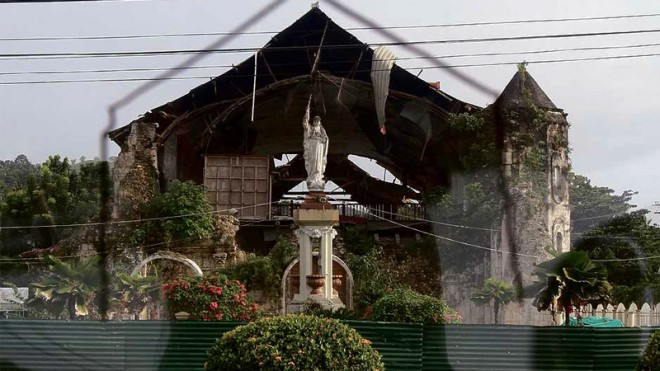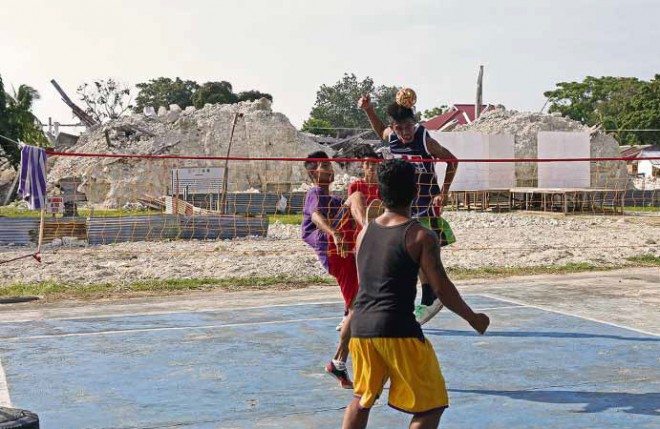A year after big quake, rehab funds still hanging

SOLID FAITH This is how the historic Loboc town church looks now, a year after a powerful earthquake struck Bohol province and heavily damaged or destroyed hundreds of houses and dozens of churches. MARIANNE BERMUDEZ
(Second of three parts)
SAGBAYAN, Bohol—For eight months, local officials and employees had to hold office inside tents after the strongest earthquake to hit the province in years left the municipal hall in ruins.
In June, they found relief when they transferred to a makeshift building made of plywood and GI sheets beside a vacant lot where the municipal hall once stood.
The mayor’s office was on the left wing while the vice mayor’s office and session hall were on the right.
At the center were the various departments separated by walls of plywood.
Article continues after this advertisementThe municipal hall cannot be rebuilt for lack of funds from the national government, said Felito Pon, head of the Municipal Disaster Risk Reduction and Management Office (MDRRMO).
Article continues after this advertisementSagbayan, the epicenter of the 7.2-magnitude earthquake, was supposed to receive P242 million for the repair of infrastructure, classrooms and houses.
But not a single centavo has reached the local officials—a year after the quake.
Paper work
“A lot of paper work, like detailed engineering design, has delayed the release of funds,” Pon told the Inquirer.
“We really wanted to have them (the rehabilitation funds) earlier,” he said. “We are hoping that by the end of this year we can start the repairs.”
None of the 20 damaged municipal and City Halls has been rebuilt a year after the tremor.
These are in Tagbilaran City and the towns of Loon, Cortes, Tubigon, Sagbayan, Antequera, Balilihan, Catigbian, Corella, Maribojoc, Sikatuna, Buenavista, Danao, San Isidro, San Miguel, Candijay, Dimiao, Loay, Pilar, Sevilla and Sierra Bullones.
Funds delayed
Not one of the 15 municipal halls has been repaired. These are Calape, Dauis, Panglao, Clarin, Inabanga, Alburquerque, Baclayon, Dagohoy, Trinidad, Alicia, Batuan, Carmen, Duero, Loboc and Valencia.
The local officials are still waiting for the release of P2.461 billion in rehabilitation funds that were turned over to Gov. Edgar Chatto by Interior Secretary Mar Roxas and Budget Secretary Butch Abad on June 6.

BOUNCING BACK These young men enjoy playing “sepak takraw” near the ruined Our Lady of the Light Church in Loon town, Bohol province, a year after a 7.2-magnitude earthquake destroyed parts of the town. LITO TECSON/CEBU DAILY NEWS
The amount is only about 20 percent of the P12 billion sought by the province in its rehabilitation and recovery plan submitted last January.
Memorandum of agreement
Red tape has further delayed the release of the funds, called Bohol Earthquake Assistance (BEA), under the Department of the Interior and Local Government (DILG).
A memorandum of agreement had to be signed first by the chief executives of the 43 towns and city. This was done only on Sept. 22.
The agreement provided that only those local government units capable of conducting rehabilitation would receive funding, according to Ananias Villacorta, DILG director for Central Visayas.
The provincial government would undertake the rehabilitation work for those not capable of doing it, he added.
Getting annoyed
But before the funds would be downloaded to the LGUs, Villacorta said his office had to revalidate first if the program of work and other documents were in proper order.
Mayor Leoncio Evasco Jr. of Maribojoc town said he had been regularly attending the meetings with other town mayors about the BEA. And he was getting irritated.
“Until the last week of September, we were still discussing policies and guidelines [for BEA-DILG funding]. I am annoyed by it,” he said.
However, Mayor Evasco said that despite the slow release of funding from the national government, this had not prevented them from recovering and rehabilitating.
Private groups
“We are still waiting for the funds but we have not prevented private groups and individuals from giving us assistance,” he said.
The provincial government has asked P12 billion from the national government for Bohol to fully recover from the quake.
Rehabilitation plan
Based on the rehabilitation and recovery plan submitted by Bohol government, the province needs P1.598 billion to rebuild/repair houses; P4.988 billion for roads, bridges and water system; P1.183 billion for schools; P680 million for medical facilities and birthing center; P834.77 million for municipal halls, gymnasiums, barangay (village) halls, daycare centers, parks and plazas; P181.16 million for tourism facilities; P864.03 million for ports; P32.88 million for police stations; P7.54 million for women’s desk and other facilities; and P94.62 million for fish ports and and support facilities;
The province also needs to repair irrigation facilities, P53.5 million; state colleges and universities, P133.40 million; fire stations, P11.52 million and historical sites, P736.87 million.
Farmers, too
At least P928.74 million has been requested to help the farmers whose farmlands were damaged by the earthquake.
But funds from the national government haven’t come as fast as expected.
So a year after, repairs on 14 roads, government buildings, hospital and health centers and other facilities have yet to be completed.
Fortunately, the private sector and the Boholanos themselves have stepped up their efforts. They didn’t wait for help from the national government, especially for the construction and repair of houses and classrooms.
(Conclusion tomorrow: Lessons learned a year after)
FIRST PART